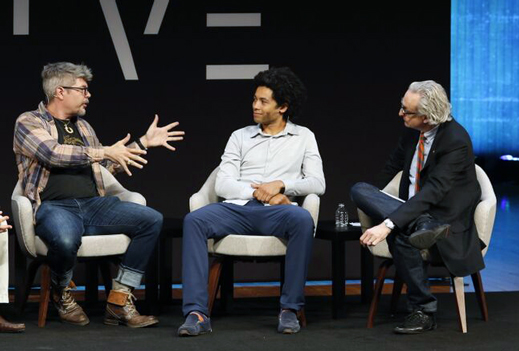Facebook’s Internet Drone Team Is Collaborating with Google’s Stratospheric Balloons Project
Facebook and Google compete intensely for your time online and for the ad dollars of corporations. But now the two companies are collaborating on efforts to use balloons and drone aircraft to expand Internet access to the four billion people that don’t have it.

Documents filed with the U.S. Federal Communications Commission show that both companies are pushing for international law to be modified to make it easier to use aircraft around 20 kilometers above the earth, in the stratosphere, to provide Internet access.
Google has been working for several years on balloons that float in the stratosphere and function as aerial cell towers to provide Internet access in areas with poor infrastructure (see “10 Breakthrough Technologies 2015: Project Loon”). Facebook is developing solar-powered drones the size of airliners for the same purpose, although they would link to ground stations, not directly to mobile devices (see “Meet Facebook’s Stratospheric Internet Drone”).
At the Solve conference at MIT in Cambridge, Massachusetts, on Monday, representatives of the competing projects said they are now working together, although they wouldn’t say exactly how.
In a session dedicated to the question of how to give everyone on earth access to the Internet, the companies were asked why they didn’t collaborate instead of running parallel efforts to achieve the same thing. “You shouldn’t presume that we’re not already working together,” said Yael Maguire, who leads Facebook’s Connectivity Lab working on Internet access. Rich DeVaul, who was leader of Google’s balloon project when it first began in 2011, confirmed that the leaders of the two projects are talking. “I’m looking forward to collaborative possibilities as well as some friendly competition,” he said.
Maguire later declined to tell MIT Technology Review what exactly the two companies are combining forces on. “We are collaborating on certain things,” he said.
Facebook and Google’s projects overlap in many ways, not just their end goals. For example, both companies are working on using lasers to transfer data rapidly, whether between stratospheric balloons, in the case of Google, or between drones and from drones to the ground, in the case of Facebook. Google also has a project of its own investigating drones for Internet access, although it, like Facebook’s project, is at a much earlier stage than the balloon effort.
The two companies also face the same policy challenges. Using stratospheric drones or balloons at large scale will require changes to rules governing the use of airspace and wireless communications.
On June 11, Facebook and Google both filed letters with the FCC urging it to back an International Telecommunication Union motion concerned with making specific radio spectrum available to encourage deployment of “high altitude platform stations”—i.e. balloons and drones—for Internet access. If that idea gets enough support it will be discussed at the ITU’s World Radio Communication Conference in November this year. The event, held every three or four years, is a forum for revision of the international treaty that governs use of radio spectrum and communications satellite orbits.
However, even if Google and Facebook work together, corporations alone cannot truly spread Internet access as widely as is needed to promote equitable access to education and other necessities, says Nicholas Negroponte, a professor at MIT’s Media Lab and founder of the One Laptop Per Child Project.
“I think that connectivity will become a human right,” said Negroponte, opening the session at which Facebook and Google’s Maguire and DeVaul spoke. Ensuring that everyone gets that right requires the Internet to be operated similar to public roads, and provided by governments, he said.
Google and Facebook’s projects so far appear to be focused on working with existing telecommunications companies, not governments. Google plans to lease access to its balloons to existing wireless carriers, and is already running trials with several in the Southern Hemisphere. Facebook’s drone system is not yet ready for full-scale tests, but it has said it plans to release details of some of its technology for free.
Negroponte said that corporate projects like those may help drive down the cost of the infrastructure needed to widen access. But for billions more people to be brought online, it needs to be deployed by the public sector, he said. “The UN should launch and operate a low Earth orbit satellite,” he told MIT Technology Review.
Keep Reading
Most Popular
Large language models can do jaw-dropping things. But nobody knows exactly why.
And that's a problem. Figuring it out is one of the biggest scientific puzzles of our time and a crucial step towards controlling more powerful future models.
The problem with plug-in hybrids? Their drivers.
Plug-in hybrids are often sold as a transition to EVs, but new data from Europe shows we’re still underestimating the emissions they produce.
Google DeepMind’s new generative model makes Super Mario–like games from scratch
Genie learns how to control games by watching hours and hours of video. It could help train next-gen robots too.
How scientists traced a mysterious covid case back to six toilets
When wastewater surveillance turns into a hunt for a single infected individual, the ethics get tricky.
Stay connected
Get the latest updates from
MIT Technology Review
Discover special offers, top stories, upcoming events, and more.